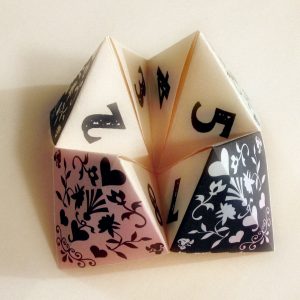For Deathly Encounters!, an evening event hosted at the Museum of Archaeology and Anthropology in central Cambridge, we were excited to trial two new variations on our workshops. In both cases, the value comes from engaging with historic approaches to death in culture, and from the rich conversations which are prompted by social handicrafts.
- Mourning ribbons
For this activity, participants could grab a drink and join us at the craft table to learn about the traditions of mourning ribbons.
In Western culture, mourning ribbons and mourning jewellery have been used back to the 14th century. They include rings, beads, ribbons and rosettes, usually black in colour, and often incorporating some commemoration of a specific person who has died. In some case, mourning jewellery includes images of the deceased, locks of their hair, or even teeth.
In the eighteenth century, strict social codes around mourning required widows, widowers and other relatives to wear different degrees of black and sombre-coloured clothing, thus visible and publicly marking the period of mourning which could last several years. Mourning ribbons are used to this day, sometimes as symbols of activism rather than personal connection to a dead person.
In practice, then, it was necessary after a death for the family – primarily the women and servants – to arrange quickly for clothes and accessories to be altered to add black ribbons and crepe, veils and black stone jewellery. In our workshop, we try our hand at creating mourning ribbons and memento mori whilst discussing what effects it might have had on the experience of bereavement and grief to engage in the family ritual of mourning.
- Fortune tellers
This activity asks participants to recall the playground game of folding origami fortune tellers. Using some beautiful paper we asked each crafter to take their time and choose words which they connected to death and dying. The responses were startling in their variety. The fortune tellers could then be passed around for others to discover.
A fortune teller is a playful way to recall words and ideas that are important to you, and to place these in dialogue with other perspectives. For inspiration, you might use a poem, picture or phrase as the basis for the selection of words. You could use all verbs, or all nouns; colours; questions; words connected to the body; words connected to a person. Vocabulary of the natural world were common. One visitor to the stand wrote messages of hope and comfort. One participant wrote “game over” on all eight triangles.


Posted: